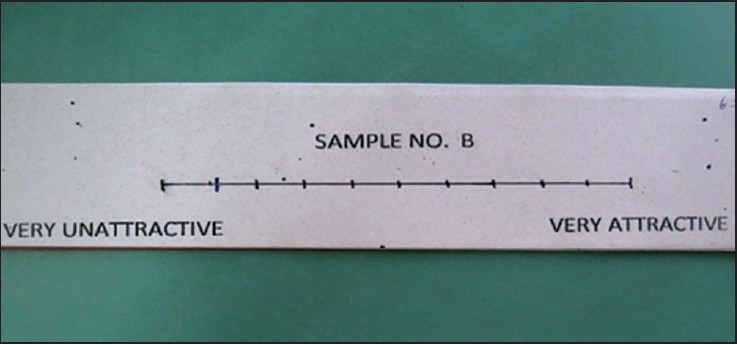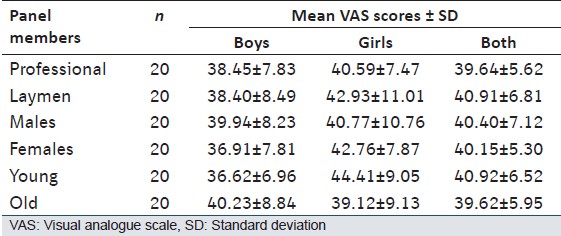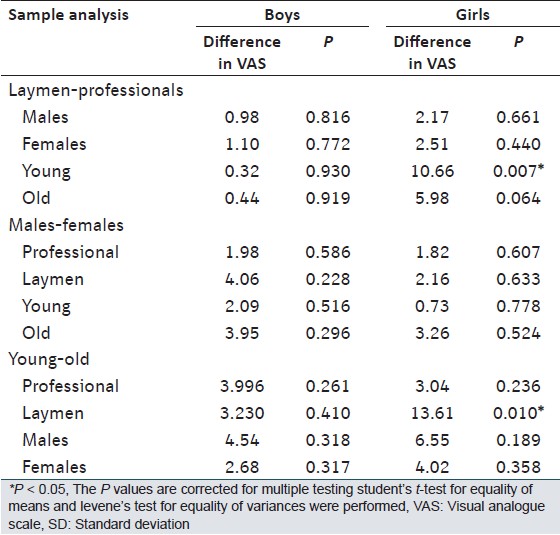|
 
 |
| ORIGINAL ARTICLE |
|
| Year : 2015 | Volume
: 3
| Issue : 1 | Page : 25-29 |
|
Evaluate the influence of panel composition on facial attractiveness
Rajkumar Maurya1, Ankur Gupta2, Jaishree Garg2, Chandresh Shukla3
1 Corps Dental Unit, Department of Orthodontics and Dentofacial Orthopaedics, Bareilly, India
2 Department of Orthodontics, IDS, Bareilly, India
3 Department of Orthodontics and Dentofacial Orthopedics, Peoples College of Dental Sciences and Research Centre, Bhopal, Madhya Pradesh, India
| Date of Web Publication | 29-Dec-2014 |
Correspondence Address:
Rajkumar Maurya
Corps Dental Unit, S I Lines, Bhopal 462001
India
 Source of Support: None, Conflict of Interest: None  | Check |
DOI: 10.4103/2321-3825.146361

Introduction: The study was conducted to evaluate the influence of professional background, age and gender, of panel members on their evaluation of the facial attractiveness of adolescents. Materials and Methods: A panel of 20 adult laymen 20 professionals (orthodontist and maxillofacial surgeons) evaluated photographic sets (one frontal and one lateral view) of 170 adolescents (76 boys and 94 girls) on a visual analogue scale (VAS) in relation to a reference set of photographs. The effects of the characteristics of the panel members on the VAS scores for boys and girls separately, as well as their interactions, were evaluated by multilevel models. Statistical Analysis: The influence of professional background, age and gender on the VAS scores for the boys and the girls separately and their possible interactions were tested within the framework of multilevel models. Student's t-test for equality of means and Levene's test for equality of variances were performed. Conclusion: The multilevel model and first-order interactions revealed that laymen rated adolescents as more attractive than professionals. Male laymen rated the boys and girls significant more attractive than male professionals. Young laymen rated boys and girls significantly more attractive than young professionals. Young laymen rated girls significantly more attractive than old laymen. Keywords: Ethnic difference, facial attractiveness, photographs, visual analogue scale
How to cite this article:
Maurya R, Gupta A, Garg J, Shukla C. Evaluate the influence of panel composition on facial attractiveness. J Orthod Res 2015;3:25-9 |
How to cite this URL:
Maurya R, Gupta A, Garg J, Shukla C. Evaluate the influence of panel composition on facial attractiveness. J Orthod Res [serial online] 2015 [cited 2018 Sep 6];3:25-9. Available from: http://www.jorthodr.org/text.asp?2015/3/1/25/146361 |
| Introduction | |  |
Estheticsν is the study of beauty and philosophy of art. The esthetics results of our treatment are often of great interest to the patient than the achieved occlusal changes. In orthognathic surgery and orthodontic practice a diagnosis is determined, in part, by comparing patients cephalometric measurements of standard norms. These norms however may be specific to a particular ethnic group and cannot always be compared for surgical and orthodontic treatment planning of patients belonging to other ethnic types. Ethnic and racial differences play a major role in diversifying esthetic preferences. Several factors such as sex, age, education, socio-economic status, and geographic location also affect the esthetics preferences of the public. When planning a treatment, orthodontic standards must concur with the publicís esthetic perceptions and norms. [1] As dental professionals we are conditioned for good occlusion and straight profile as esthetically pleasing, but what is most important is trying to recognize and understand the general publicνs esthetic concept above our own esthetic prejudice.
In investigations of facial aesthetics, judgments of panels have often been compared, but conflicting results have been reported. Differences in study design may, to a large extent, be responsible for these conflicting results. In addition, factors related to the individual characteristics of the panel members such as professional background, age, gender, and geographical region may also influence the ratings. [2] Although high correlations have been reported between professionals and laymen. [3],[4],[5] Some investigations have shown that professionals are more critical than laymen [5],[6] whereas other studies found the opposite. [4],[7] Differences in panel composition concerning age and gender can be confounders in this respect. [4] The age of panel members was not found to be influential on their ratings of facial esthetics. [8],[9] The influence of gender of panel members on their ratings of facial esthetics is not clear. Some studies indicated that the gender of panel members was not decisive for their ratings. [9],[10] Cross and cross found that female laymen rated female faces as more attractive than male laymen whereas female and male laymen rated male faces the same. [8]
Panel size is another issue that should be taken into consideration. The literature shows a wide range in panel size. [5] Howells and Shaw stated that for evaluation of facial aesthetics, a panel of two persons can give acceptable reliability, but for improvement, they advocated a further increase in panel size. [9] The aim of the present study was to evaluate the influence of, and the possible interaction between, professional background, age, and gender of the panel members on their perception of facial attractiveness.
| Materials and Methods | |  |
Subjects
A total of 540 students were examined from different colleges of North India. From these students a sample of 170 individuals, 76 males and 94 females in the age group of 18-24 years was selected based on facial profile and status of occlusion. All the individuals were Hindu and taken from the original inhabitants of Punjab, Haryana, Uttar Pradesh, Delhi, Uttarakhand, Rajasthan and Madhya Pradesh. To ascertain the place of origin of the subjects, the family lineage of each subject was traced up to three generations. The selection criteria for the present study was to judge the individual on the basis of well aligned maxillary and mandibular dental arches, Angleνs Class I molar relationship with minimal or no crowding, normal overjet and overbite, no history of previous orthodontic, prosthodontic or surgical treatment, and esthetically pleasing appearance.
Facial frontal and profile photographs of 170 individuals were taken. Two panels of judges were made, which consisted of 20 laymen and 20 professionals (orthodontist and maxillofacial surgeons). They screened the 170 sets of photographs.
Methods
Standardized facial frontal and profile photographs were taken with the patient in the natural head position (NHP), [11] centric relation, and relaxed lip posture. In order to take the records in NHP, the subjects were asked to look into their eyes in the mirror, which was positioned 110 cm from the subjects. All photographs were taken with a Nikon digital D40X camera mounted on a tripod. The tripod controlled the stability and correct height of the camera according to the subjects body height. This ensured a correct horizontal position of the optical axis of the lens (Macro Nikon Lens 105 mm; Tokyo Japan). A 105 mm focal lens was selected in order to maintain the natural proportions. The camera was used in its manual position; the shutter speed was 1/125/s, and the opening of the aperture f/11.
The subjects were positioned at 1.7 m from the camera. A panel of 20 laymen and a panel of 20 professionals with equal distribution among the males and females to prevent the rating from being sex-dependent were formed. The fixed effect for age was dichotomized at 38 years of age, which was the median age of the panel members, with 38 years and older- old and under 38 years- young.
These panels evaluated each of the 170 sets of photographs to select sample, which included individuals with esthetically pleasing appearance. All the photographs projected on the screen for the duration of 10 s. Each judge was given two booklets containing 170 pages of 100 mm visual analog scale (VAS). [5] VAS represents continuous scoring from 0 to 100 mm (i.e., very unattractive to very attractive) on line on which the tens were indicated from 0 to 100 [Figure 1]. Judges were asked to rate each set of photograph independently and not to return to the previous slide. The scores for each set of photographs were recorded and tabulated. Means and standard deviations (SDs) of these ratings were calculated. One male and one female photograph close to the median value were then selected to serve as a reference set [Figure 2] and [Figure 3]. The set of same photographs was placed in a slide show and projected on a wall screen, showing every female face along with the female reference set, and every male face along with the male reference set for 15 s. The panel of lay judges was asked to rate the 170 sets of photograph again, in relation to the set of reference photographs on the VAS. This method has been shown to yield reproducible and valid results. [5] | Figure 1: Visual analogue scale, represents continuous scoring from 0 to 100 mm
Click here to view |
Statistical Analysis
The influence of professional background, age and gender on the VAS scores for the boys and the girls separately and their possible interactions were tested within the framework of multilevel models. All the statistical analyses were performed with the SPSS software package (SPSS for Windows 98, version 11.5, SPSS, Chicago, III). Student's t-test for equality of means and Leveneνs test for equality of variances were performed.
| Results | |  |
Visual analogue scale means and SD of the aesthetic scores for boys, girls, and boys and girls together, for each given panel, professional background, age, and gender, were calculated and are shown in [Table 1]. Laymen rated boys and girls are significantly more attractive than professionals.
The differences in VAS score are presented in [Table 2] for professional background within subgroups, young, old, males and females, separately for boys and for girls. Male laymen rated the boys and girls significant more attractive than male professionals. There was no significant difference between the rating of laymen and professional females. Young laymen rated boys and girls significantly more attractive than young professionals. There was no significant difference between the rating of old laymen and old professional for boys and girls. | Table 1: VAS means and SD of the aesthetic scores for the photographs of boys, girls and boys and girls taken together, given by laymen and orthodontists, young and old panel members and males and females members student's t-test for equality of means and levene's test for equality of variances were performed
Click here to view |
[Table 2] shows the difference in VAS score for gender within subgroups, laymen, orthodontists, young and old, separately for boys and for girls. There was no significant difference between the ratings of male and female for boys and girls.
Differences in VAS score are shown in [Table 2] for age within subgroups, laymen, orthodontists, males and females separately for boys and girls. Young laymen rated girls significantly more attractive than old laymen. There was no statistical difference between the ratings of older and younger panel members for the boys. | Table 2: Difference in VAS means in a multilevel model with all main effects
Click here to view |
| Discussion | |  |
The perception of facial esthetics by a society can influence orthognathic surgery and orthodontic treatment decisions and individual's decision to seek orthodontic and surgical treatment. This perception is influenced by culture, education and exposure to visual familiarities of faces within the society. Facial esthetics is a subjective matter and establishing a standard is difficult. However, assessing society's perception of facial esthetics can help clinicians to determine the most acceptable standards of facial esthetics within the ethnic population. Both orthodontic and orthognathic surgical procedure can have a positive impact on facial appearance and esthetics. Hence, these procedures should be based on perception of esthetics of people belonging to their ethnic group and not on norms derived from other population with different racial background. [12]
The lay panel was composed of males and females with a relatively high socio-economic status. This was justified since orthognathic surgery, and orthoorthodontic treatment demand is higher in groups with a high socio-economic status than in those with lower status, whereas the objective treatment need is similar in both groups. [13] Therefore, the lay panel can be assumed to be representative of that part of the general public assessing orthognathic surgery and orthodontic treatment demand. The subjects in the present study were young adults in the range of 18-24 years. This correlates well with the age at which patient is self-conscious, and self-motivated and minimally influenced by others for seeking treatment to improve facial esthetics. Many investigators have used VASs, which have certain advantages. They are a rapid method of obtaining scores on a large number of stimuli by a panel of judges. They are easily understood by judges and readily accepted. VAS can introduce a level of precision beyond the discriminatory ability of the judges. [14] In this study, the ranking procedure was undertaken to produce two groups (male and female) representing a spectrum of facial attractiveness. Lay judges were then asked to rate the photographs on VAS. VASs is most often used as a measuring instrument for dental, dentofacial, or facial aesthetics. Most authors have used a VAS without reference photographs, [14],[9] but more recently the use of reference photographs has been advocated. [3],[15] Reference photographs can help the panel members to use the scale more uniformly, but preferentially their number should be minimized for the sake of simplicity of the scale. Therefore, in this study only one reference set for each sex with the median score of the scale was chosen. The rating by these judges could be taken as an indicator of the type of profile a patient or a layperson would wish to achieve after treatment.
The fact that differences were found between professionals and laymen, between older and younger panel members and males and females does not mean that they do not agree on ranking facial aesthetics or on who is more beautiful and who is less. It simply means that some groups are more critical than others in the evaluation of facial aesthetics. [5] Professionals used a larger part of the VAS than laymen, and their VAS scores within the same subject differed more than those of laymen. In calculating the computing intraclass correlations, the difference in scoring between laymen and professionals was significant - laymen do not see much difference between the subjects, but they agree more than professionals.
Clinical Implications
This study was undertaken on a large number of samples to evaluate the influence and the possible interaction between, professional background, age, and gender of the panel members on their perception of facial aesthetics. These variables have received extensive clinical and research usage in the field of both orthodontics and orthognathic surgery.
The hypothesis that the difference between professionals and laypersons exists in the aesthetic evaluation of these subjects was also examined to compare the perception of beauty in the eyes of these two groups.
Scope for Future Studies
Three-quarter (smiling) color photographs have also been advocated, and probably the most complete visualization can be achieved by the combined use of frontal, lateral and three-quarter (smiling) photographs. Such set of photographs expresses a person's whole facial attractiveness since dynamic characteristics are not taken into account.
The question as to how laymen perceive changes after different surgical procedures is another point of interest in treatment planning and merits further research.
| Conclusion | |  |
This study was designed to determine the relevance of the composition of a panel on esthetic evaluation of adolescence faces. The results showed that the differences were present in the esthetic preferences of general public and professionals.
The results of this study should be an aid in designing treatment plans that are consistent with the perception of beauty, attractiveness, and facial balance for our native North Indian population.
| References | |  |
| 1. | Türkkahraman H, Gökalp H. Facial profile preferences among various layers of Turkish population. Angle Orthod 2004;74:640-7.  |
| 2. | Kiekens RM, van 't Hof MA, Straatman H, Kuijpers-Jagtman AM, Maltha JC. Influence of panel composition on aesthetic evaluation of adolescent faces. Eur J Orthod 2007;29:95-9.  |
| 3. | Peerlings RH, Kuijpers-Jagtman AM, Hoeksma JB. A photographic scale to measure facial aesthetics. Eur J Orthod 1995;17:101-9.  |
| 4. | Spyropoulos MN, Halazonetis DJ. Significance of the soft tissue profile on facial esthetics. Am J Orthod Dentofacial Orthop 2001;119:464-71.  |
| 5. | Kiekens RM, Maltha JC, van 't Hof MA, Kuijpers-Jagtman AM. A measuring system for facial aesthetics in Caucasian adolescents: Reproducibility and validity. Eur J Orthod 2005;27:579-84.  |
| 6. | Kerr WJ, O'Donnell JM. Panel perception of facial attractiveness. Br J Orthod 1990;17:299-304.  |
| 7. | Giddon DB, Sconzo R, Kinchen JA, Evans CA. Quantitative comparison of computerized discrete and animated profile preferences. Angle Orthod 1996;66:441-8.  |
| 8. | Cross JF, Cross J. Age, sex, race, and the perception of facial beauty. Dev Psychol 1971;5:433-9.  |
| 9. | Howells DJ, Shaw WC. The validity and reliability of ratings of dental and facial attractiveness for epidemiologic use. Am J Orthod 1985;88:402-8.  |
| 10. | De Smit A, Dermaut L. Soft-tissue profile preference. Am J Orthod 1984;86:67-73.  |
| 11. | Miyajima K, McNamara JA Jr, Kimura T, Murata S, Iizuka T. Craniofacial structure of Japanese and European-American adults with normal occlusions and well-balanced faces. Am J Orthod Dentofacial Orthop 1996;110:431-8.  |
| 12. | Talic N, Alshakhs MS. Perception of facial profile attractiveness by Saudi sample. Saudi Dent J 2008;19:17-23.  |
| 13. | Wheeler TT, McGorray SP, Yurkiewicz L, Keeling SD, King GJ. Orthodontic treatment demand and need in third and fourth grade schoolchildren. Am J Orthod Dentofacial Orthop 1994;106:22-33.  |
| 14. | Phillips C, Tulloch C, Dann C. Rating of facial attractiveness. Community Dent Oral Epidemiol 1992;20:214-20.  |
| 15. | Faure JC, Rieffe C, Maltha JC. The influence of different facial components on facial aesthetics. Eur J Orthod 2002;24:1-7.  |
[Figure 1], [Figure 2], [Figure 3]
[Table 1], [Table 2]
|